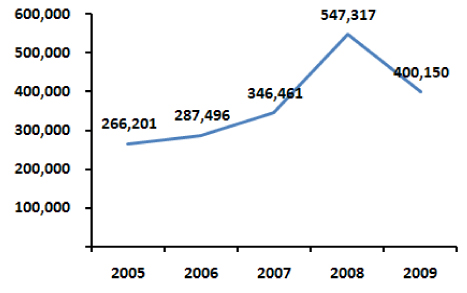Korean J Women Health Nurs.
2011 Dec;17(4):328-336. 10.4069/kjwhn.2011.17.4.328.
Methods and Estimates of the Reimbursement for the Nurse Midwifery Center in the National Health Insurance
- Affiliations
-
- 1Seoul National University Hospital, Korea.
- 2College of Nursing, Seoul National University, Korea. jinhyun@snu.ac.kr
- KMID: 2307967
- DOI: http://doi.org/10.4069/kjwhn.2011.17.4.328
Abstract
- PURPOSE
The purpose of this study is to develop the optimal nursing fee for nurse-midwifery center (MC) in the national health insurance system.
METHODS
The three methodologies used to calculate the conversion factors for the MCs in the national health insurance include cost accounting method, sustainable growth rate (SGR) model, and index model. In this study, the macro-economic indicators and the national statistics were used to estimate the conversion factors for the MCs.
RESULTS
The optimal nursing fee for the MCs in 2011 was estimated to be an increase of 57.7% by cost accounting analysis, a decrease of 17.1% by SGR model, and a decrease of 16.1% by index model. The results from SGR model and index model could had been biased due to the upswing of medical spendings in the short-term period (2008~2009). A sensitivity analysis of pre-delivery subsidy program for OB & GYN hospitals and clinics showed that the program has substantially diminished the demand for the MC services.
CONCLUSION
More reliable methodologies to estimate nursing fees precisely are required to prove the value of nurses' services and a government subsidy program for the MC services should be followed from a social perspective.
MeSH Terms
Figure
Cited by 2 articles
-
Comparison of professionalism and job satisfaction between Korean midwives in birthing centers and midwives in hospitals
Buyoun Kim, Sook Jung Kang
Korean J Women Health Nurs. 2020;26(3):222-230. doi: 10.4069/kjwhn.2020.09.08.A Concept Analysis of Labor Support
Miyoung Chae, Horan Park
Korean J Women Health Nurs. 2018;24(2):138-149. doi: 10.4069/kjwhn.2018.24.2.138.
Reference
-
1. Ahn T.S., Oh D.I., Jung H.R. Developments and applications of conversion factor estimation methodologies for medical services. Korean Management Review. 2004. 33(1):157–182.2. Ahn T.S., Oh D.I., Jung H.R. A study on the cost separation and conversion factor of the physical office based on activity based costing model. Gwallihoegyeyeongu. 2005. 5(1):57–85.3. Ahn T.S., Oh D.I., Lee Y.T., Jung H.R. A study on the hospital conversion factor based on the standard costing model. Daehan Journal of Business. 2005. 18(3):1145–1173.4. Choi B.H., Shin Y.J., Shin H.W., Oh D.I. Developing resource-based relative value and conversion factor: SGR model. 2003. Korea Institute for Health and Social Affairs.5. Choi H.K. An analysis of the dynamic process of setting fees for medical services. Health and Social Science. 2007. 22:67–95.6. Collins J.A. An international survey of the health economics of IVF and ICSI. Human Reproduction Update. 2002. 8(3):265–277.7. Folland S., Goodman A.C., Stano M. The economics of health and health care. 2005. Prentice Hall.8. Health Insurance Statistics. Health Insurance Review & Assessment Service. 2010. Retrieved October 25, 2010. from http://www.hira.or.kr/intro.jsp.9. Im H.M. The method and estimation of the health insurance fee for the midwifery center. 2010. Seoul: Seoul National University;Unpublished master's thesis.10. Kim J.H. A new approach to estimate the conversion factor of RBRVS in the national health insurance in Korea. Korea Journal of Health Economics and Policy. 2005. 11(2):33–64.11. Kim J.H., Jung Y.M. Methods and applications to estimate the conversion factor of resource-based relative value scale for nurse-midwife's delivery service in the national health insurance. Journal of Korean Academy of Nursing. 2009. 39(4):574–583.12. Kim J.H., Ryu G.C., Yoo W.G., Jung E.H., Jung H.J., Jung Y.M., et al. Estimation of conversion factors for the year 2008 in the national health insurance. 2007. Seoul: Seoul National University · National Health Insurance.13. Kim J.H., Ryu G.C., Yoo W.G., Lee T.J., Kim S.J., Jung Y.M., et al. Estimation of conversion factors for the year 2009 in the national health insurance. 2008. Seoul: Seoul National University · National Health Insurance.14. Kim Y.M., Nam H.K., Sung Y.H., Park H.Y. A survey for developing strategies to improve the fees for nursing care. Clinical Nursing Research. 2008. 14(1):5–14.15. Ministry of Health and Welfare. Health Insurance Policy Review Committee's press release. 2010. Seoul:16. National Health Insurance Corporation. National health insurance statistical yearbook (2008, 2009) [data file]. 2010. Seoul: National Health Insurance.17. Oh D.I. A stream of research on conversion factor of fee for services in Korea medical system. Journal of Industrial Science Institute. 2002. 12:1–25.18. A review of the increased fee for delivery services in the national health insurance. Press release. People's Solidarity for Participatory Democracy. 2010. Retrieved June 20, 2010. from http://blog.peoplepower21.org/welfare/41319.19. Yang B.M. Health economics. 2007. Seoul: Nanam.20. Yoo W.K. Estimation of conversion factors of the midwifery service for the year 2010 in the national health insurance. 2009. Seoul: Korean Nurses Association.
- Full Text Links
- Actions
-
Cited
- CITED
-
- Close
- Share
- Similar articles
-
- Methods and Applications to estimate the Conversion Factor of Resource-based Relative Value Scale for Nurse-Midwife's Delivery Service in the National Health Insurance
- Nurse-midwifery education through graduate programs to provide a sufficient number of high quality nurse-midwives
- Model Development of Nursing Care System for Women's Health : Based on Nurse-Midwifery Clinic
- The process by which new health technology is listed for insurance coverage
- A New Healthcare Policy in Korea Part 1: Expanded Reimbursement Coverage of Brain MRI, Brain/Neck MRA, and Head and Neck MRI by National Health Insurance



